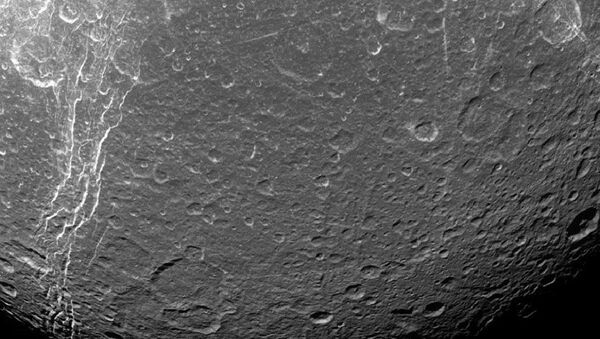The Chang’e-4 lunar probe is expected to be launched at about 18:30 GMT from the Xichang space center in China’s Sichuan province, and land in the largest and deepest crater of the Moon, the South Pole-Aitken (SPA) basin, in January.
Chang'e-4 Mission
China'd Chang’e lunar far side mission, named after the mythical goddess of the Moon, includes three stages: orbiting, landing and returning to Earth. The first stage has already been successfully completed, while the second is currently being implemented.
The Chang’e-4 unit consists of a lunar station and a lunar rover.
READ MORE: China Will Launch First Probe to Moon's Far Side Later This Week (PHOTOS)
The new rover looks like its predecessor but, according to the developers, is the lightest apparatus of this class. In addition, the model was further developed because the terrain on the far side of the Moon is much more complex.
Moon's Far Side
The far side of the Moon is not visible from Earth. Due to the fact that the Moon’s period of rotation around Earth and its rotation about its axis are identical, only one hemisphere of the Moon can be observed from Earth at any point. The world’s first image of the far side of the Moon was captured on October 7, 1959, by the Luna-3 Soviet station, but until today, no spacecraft from Earth has ever reached it.
The hemispheres of the Moon differ from each other in many ways. Currently, scientists have little information about geological and electromagnetic conditions on its far side, so the developers of the spacecraft had to solve many technical problems, including the issue of communication.
Landing on the far side means that the Moon will separate the spacecraft from Earth, making it impossible for the probe to communicate directly with our planet. That is why the relay satellite named Queqiao will be responsible for transmitting signals between the Earth station, and the Chang’e-4 lander and rover.
In June this year, the Queqiao successfully reached the Earth-Moon L2 Lagrange point on the far side of the Moon, becoming the first satellite in the world to operate in this halo-orbit.
Astronomers believe that despite the successful experience of the Chang’e-3 station, landing the Chang’e-4 would still involve great risks, because many previous spacecraft lost contact with Earth as they approached the far side of the Moon.
The Chang’e-4 is an unmanned apparatus, which naturally reduces the risk, but it will still be a challenge for engineers to ensure the commands during the approach of the space probe to the far side of the Moon, the precision landing of the probe to a specified point, using a remote control, and the successful transmission of images to Earth.
If the mission is successful, scientists will have the opportunity to better explore Moon's environment, which will be a great leap forward not only for China, but for the whole world.
China's Lunar Plans
China does not intend to stop at this point, and its plans for the future include delivering lunar soil to Earth. China’s Chang’e-5 mission to return samples from the Moon was scheduled to take place in November 2017, but due to the unsuccessful launch of the most powerful Chinese carrier, Chang Zheng-5 (Long March-5), in July of that year, the mission had to be postponed.
In November, Director for International Cooperation in the China National Space Administration Xu Yansong told Sputnik that the next test launch of Chang Zheng-5 was scheduled for 2019. Currently, engineers are addressing technical issues. The date, the Chang’e-5 mission remains unknown.
According to Xu, China’s Chang’e-6's second return mission is open to international cooperation, while Chang’e-5 is a "domestic" mission on which the country's future lunar program will be based.
Afterward, China intends to send its astronauts to the Moon by 2036. According to Chinese scientists, it will take 15-20 years for China to land astronauts on the lunar surface.
Other Countries' Lunar Programs
Russia also has a lunar program, which includes sending several orbiting vehicles and lunar module descent engines to the Moon, creating a long-term base on its surface and studying the Moon using robotic avatars. The first landing of the Russian cosmonaut on the Moon is scheduled for 2030, while the launch of the Luna-25 spacecraft to test technologies for a soft landing is planned for 2020.
READ MORE: Russian Cosmonauts Expected to Land on Moon After 2030
In addition, Russia, together with the United States and other partners in the International Space Station, is discussing the possibility of creating a lunar orbital station.
READ MORE: Roscosmos, NASA to Work Together on Concept of Lunar Orbital Station — Director
India plans to send the Chandrayaan-2 automatic station to the Moon in 2019. It will land on the Moon and deliver a small rover to its surface.
The launch of the first Israeli spacecraft for lunar exploration is planned for the first quarter of 2019.
The US leadership was unable to determine the future purpose of the lunar program. In 2003, President George W. Bush resumed the lunar program. It included flights to the Moon and creation of a permanent base there with the prospect of a flight to Mars. In 2011, President Barack Obama shut the program down. In December 2017, US President Donald Trump signed a decree to reinstate the lunar program.
READ MORE: Ticket to the Moon: SpaceX Names Its First Lunar Passenger



